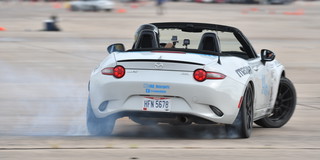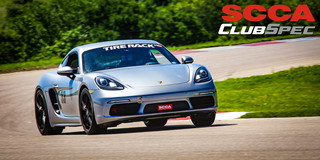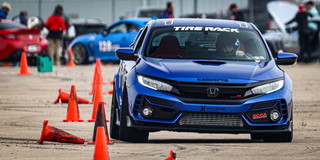
This article first appeared in the July, 2020 edition of SportsCar Magazine. Everyone can read the current and past editions of SportCar digitally here. To become an SCCA member and get SportsCar mailed to your home address monthly in addition to the digital editions, click here.
What would your electronic nannies do?
I had an epiphany during a radio interview on Bud’s Garage. (Yes, radio. I know, it should be a podcast. I have some old friends.) My last epiphany came during a ProSolo in 1983, so these don’t happen very often – but that one benefited me my whole life. See Pobst Position “My Epiphany,” to be part of my compilation book of the same name, coming soon.
But I digress.
Power out of trouble? What would your electronic nannies do? By now, nearly all of you sporty-car type maniacs must have experienced the intervention-slash-car-saving actions of stability controls. Annoying sometimes, saving your sorry behind others, and probably many times you never even realize it. Aggressively cutting throttle, applying brakes, all the time when you want to go. Don’t you hate it? Have you ever thanked the engineer or designers for keeping you out of the wall?
My epiphany is this: Have you ever felt your stability control add power? This is so important I’m going to ask you again in boldface: Have you ever felt your stability control add power?
And, since we are in this antique one-way form of communication called “reading a column,” I will answer for you: No! Absolutely not. Never. Your electronic nannies will never go to throttle. I know I am being redundant here, I’ve written of this before, but this one truth really drives it home.
Let me have a show of hands (another example of something that works really well in a magazine): How many of you believe that you can power out of trouble? Don’t be shy now, get your driving-gloved hands up. There’s a lot of you. I know this because I have spent so much time with you for, lo, these many wonderful speedy-driving years.
Power is your friend – until it isn’t. Power is your friend when everything is alright. Power is your friend when you are in complete control. Power is your friend when you know where you are going. When all’s well, your tires still have traction, so power transfers weight to the rear, increasing the grip back there, making the car more stable.
Power is not your friend when you are in trouble. Just ask your PSM (Porsche Stability Management). Power is not your friend when you just might lose control. Power is not your friend when you’re worried, or downright scared, scrambling for control, trying to catch a slide that’s too wide or too quick – a “Yikes!” moment. These are seminal moments in a driving career. Will you spin or not? Will you win or not? Will you crash or not? Will you destroy your car and end your high-performance driving career or not? Knowing when to use power is one of the three fundamentals of car control, along with always looking where you want to go, and recovering the steering when you steer into the skid and catch the slide. Take a car control clinic.
Trouble is defined by how much the tires are sliding. And too much rear slide is way more difficult than too much front, though both issues require the driver to ease off the throttle. You will definitely find your electronic driver aids cutting back on power if you get greedy; that’s traction control, but you’ll never find them rolling power on.
Power in times of trouble: “If you are not sure where you are going, why go there faster? When you’re in trouble, throttle only makes you crash faster. When in doubt, both feet out.” Quotes from my mentor and hero Terry Earwood and the Skip Barber Racing School, once again.
I’ve got to complete the set: “If you spin, both feet in.” Also, a Terry and Skippy phrase, just in case you missed some of my earlier columns. If you totally lose it, jam the brakes, and hold ’til stopped. Clutch, too – evermore rare in today’s world, I know – to keep the engine running.
I know, I know, you say you have “saved” the car many times by jamming on the gas to “power out of it.” Well, if that worked, then you weren’t really in trouble, or God saved it, not you, my fortunate friend. Here’s why: If you are at or beyond the limit of tire grip, then what happens when you add power? You make it worse, because adding power can only make it slide more. A sliding tire cannot handle the increased torque. Drift, anyone? What you need is less siding to regain control. Reduce the slide by counter-steering, not with power. Fix it with your hands, not your feet. Make sense?
If accelerating made your car more stable, then the rear tires had enough traction to transfer weight back and improve rear grip, and you just got lucky. Or maybe you had all-wheel drive or front-wheel drive, and the front tires had enough traction to transfer some weight to the back. All-wheel drive could help or hurt a slide by accelerating, depending on the torque split. Front drive will actually help it, but if you counter-steer and don’t recover the steering, it’ll hook-slide and shoot you off into the next county anyway. It’s risky for that reason, but even if backwards in a front-drive car, throttle can still straighten it out – sometimes. I’ve done it. Test this hypothesis at your own risk.
To be your helpful friend, power has to come into play early, before the trouble starts, when it can move weight back. A little power makes a car more stable if it’s hooked up. Staying on the gas helps keep it stable. Unless something gets you all slideways, then you’ve got to back off. Snapping abruptly off the gas can get you in trouble, too, of course, but if you’re already too sideways then it won’t matter any more, so stay away from the loud pedal. Catch it with your hands, your steering.
I have not yet encountered electronic controls that correct and recover steering for us, but they do often use the brakes to straighten a car. Just last year I saw a driverless prototype from Stanford University drifting a skidpad at Thunderhill Raceway, so it’s a safe bet it’s coming.
So, never think to power out of trouble, you’ll just crash harder (except front-drives). Remember, does your stability control ever add throttle? Absolutely not.
Words by Randy Pobst
Image by Rupert Berrington










